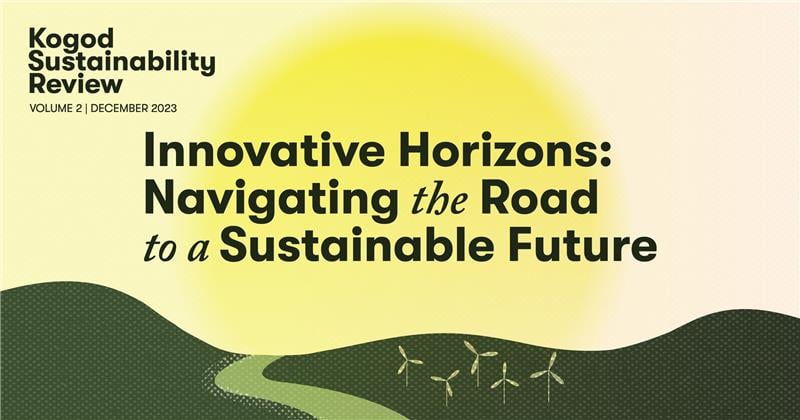
Isabela Barriga
MS in Sustainability Management Student, Kogod School of Business
If communications have the power to shape hearts and minds, then why is it so challenging to bring together collective action for shared prosperity? Science shows that when someone tells a story, neurons fire in your brain which activate emotions as the brain literally becomes in sync with the storyteller (McFalls).
Then why isn’t humanity on the same wavelength to create change when we are flooded with anxiety-inducing reports such as extreme heat waves and floods exacerbated by climate change?
You would think that climate narratives illustrating the power of action from the local to the national level would connect with more people and persuade them to fight the climate crisis. Yet, scientists and climate activists alike are still faced with having to convince people to “give a forage” (for my fellow environmentalists) and join the sustainability club where we’re working hard towards a future for all by advancing science-based climate solutions and strategies.
It’s easy to feel discouraged when the sustainability narrative has become convoluted with media hits like the climate hoax and the environmental, social and governance (ESG) backlash. In an age where we are inundated with information and click bait news, how do you grab the public’s attention and create a call-to-action? (I think climate change needs a new public relations (PR) manager).
How can this be achieved? Let’s do a marketing 101 breakdown through the lens of a sustainability professional.
- Green marketing is the promotion of brands and products based on their perceived level of environmental sustainability (Emeritus).
- Sustainability marketing builds on the above strategy by taking social and environmental impact into account through a more expansive look at how companies are promoting brands based on their level of ESG sustainability (Murphy).
- Purpose-driven marketing has emerged as a tactic for organizations to anchor external communications efforts around social cause(s) that align with their core values (Charles).
How Do You Foster a Shared Purpose?
Integrating marketing with shared value, creating economic value while addressing societal issues, can help companies generate value for customers and throughout their supply chain by appealing to the principles and causes that a company cares about (Srivastava et al.) In this case, purpose is the fuel driving the company car (electric and energy efficient, of course) on the road to sustainability as a force for good (Aziz).
The idea is that we can move from shareholder-driven capitalism where only the needs of investors are prioritized to a stakeholder-driven model where multiple stakeholders from consumers, employees, investors, communities, and the planet’s needs are considered.
While that all sounds great, I find marketing paradoxical in advocating for more “sustainable consumption” as the world is seemingly falling apart—climate refugees are being forced to migrate from their homes, wildfires are increasingly getting worse and spreading, landfills are overflowing with mountains of fast fashion and other waste (can you sense my climate anxiety?). And yet, I see ads on how to be an eco-influencer or a “sustainable baddie” with the latest and greatest stainless-steel tumbler (I have collected a small family of vacuum insulated reusable water bottles, how many more do I need?).
How can we justify buying more stuff, even if it’s marketed as being less harmful for the environment, when the unregulated fossil fuel industry driven by capitalism contributed to much of the environmental destruction that we’re witnessing today?
Well, maybe we’re telling the wrong story.
If we can light up the brain with positive imagery and weave the human element into the messaging and overall brand to save the planet, perhaps we can avoid the quick band aid effect from greenwashing and misleading environmental claims which can undermine consumer trust and hinder progress in the environmental movement."

Isabela Barriga
MS in Sustainability Management Student, Kogod School of Business
As trust between the marketer and consumer is essential for having a shared conversation on what we care about, how can we work towards being authentic about where we are at in our sustainability journey? Will this convince companies and shareholders to be real, no shame, and work towards a unified purpose?
An Expert’s Take on Communicating Value
I spoke with Professor Ron Hill who teaches Understanding the Marketplace, a key course offered in the MS in Sustainability Management program at the Kogod School of Business. I wanted to get an expert’s take on marketing in this ever-evolving sustainability field and learn how American University is preparing a younger generation of leaders to tackle new territory for communicating the value of shared prosperity.
“Most marketing concentrates on how to speak to consumers or how sustainability can be a benefit to consumers. The concentration is on stakeholders. If sustainability professionals cannot get others in an organization to agree that sustainability is an important goal, then nothing happens,” says Hill.
Therefore, marketing can be seen as one of the tactics that anyone can whip out from their sustainable toolbox to help make the business case for sustainability.
“If you can’t communicate to various constituencies as to why sustainability is important and what are the benefits, with the understanding of what their backgrounds are and why sustainability could be good or bad from their perspective, then you’re not going to be successful” says Hill.
Students need to have an understanding of what marketing is in their toolbox to recognize places where sustainability can be discussed in a beneficial way that considers benefits across a variety of constituencies.”

Ron Hill
Professor of Marketing, Kogod School of Business
Perhaps marketing is a conversation starter, a little appetizer before a main course diving into a meaty (plant-based, don’t come at me) dialogue between the marketer and the stakeholder. While we all have different perspectives, wants, and needs, the goal is to come to a common understanding on how we can take concrete steps towards collective good.
If we all have a role to play in fighting the climate crisis, we need all voices and perspectives. Maybe that is how we market our shared story by showcasing the art of relationships across people, planet and profit, but conveying the impact at a larger scale.
Knowing that we are all not communications professionals, and expression can take many forms, where does one start? Marketing can be viewed as learning a new language, but in the eyes of the stakeholder you’re trying to reach. Hill’s course prepares students to do just that.
One of the main projects of the marketing course is conducting a sustainability audit of a company of choice, assessing their actions, and offering recommendations for improvement. “The goal is for students to figure out how best they should communicate these ideas to various constituencies to make the business drive sustainability practices,” says Hill.
What better way to learn about marketing than by doing it! Acknowledging that there is subjectivity in the assessment of how “sustainable” an action or company is, can we at least agree that for something to be considered sustainable, it should be creating less harm (or ideally none) for future generations? While there is no straightforward answer to this in the realm of ethics, I think that we can compromise diverse interests by aligning on how to create shared value. I believe this is the key to catalyzing the change we want to see. With a moral compass in one hand, successful marketing is, symbolically, the other hand reaching out to others as an invitation to join you.
You don’t communicate well with people by trying to force them to think you are right. You communicate well with people when you find commonalities across individuals you are dealing with and persuade them to consider points of view in your mutual best interest."

Ron Hill
Professor of Marketing, Kogod School of Business
Let’s Tell the Story of a Sustainable Future, Together
As someone who would repel at the idea of marketing, I’ve come to understand that we have the power to make decisions every day, from our spending power to our choice of words, to advocate for the world we want to see. Communications and marketing are powerful tools that can connect humans, making the burden and challenges of the climate crisis not solely rest on one person’s shoulders. You also don’t need to be a perfect environmentalist to play a concrete role. In fact, being open about our shared shortcomings, fears, and gaps can help us identify solutions and navigate the winding road to a sustainable future, together.
How do we get people on board? Make them feel that they are a part of something bigger than themselves. Invite them to be a part of community where sustainability solutions and the people working tirelessly for a better planet are celebrated. To create a shift towards global change, let’s build networks where our needs, desires, and hopes are honored in a safe space to exchange stories, connect, and thrive.
If you’re up to the challenge, perhaps we can all be PR agents in the face of climate change, and fight for a shared vision of a healthy and equitable future for all. To spark an electric signal that generates a wave of collective action, why not start by sharing your story?
Citations
- Bauer, Ted. “The Neuroscience of Storytelling.” NeuroLeadership Institute, 30 Sept. 2021, neuroleadership.com/your-brain-at-work/the-neuroscience-of-storytelling/. Accessed 04 Dec. 2023.
- Emeritus. “How Green Marketing Helps Brands Build Loyalty While Saving the Planet.” Emeritus, 9 Dec. 2022, emeritus.org/blog/sales-and-marketing-green-marketing/.
- Murphy, Tim. “How Do Green Marketing and Sustainable Marketing Differ?” TechTarget, 27 Jan. 2023, www.techtarget.com/searchcustomerexperience/feature/How-do-green-marketing-and-sustainable-marketing-differ.
- Charles, Khalem. “What Is Purpose-Driven Marketing?” Ad Council , 25 Jan. 2023, www.adcouncil.org/all-articles/what-is-purpose-driven-marketing.
- Srivastava, Rajendra K., et al. “Marketing, Business Processes, and Shareholder Value: An Organizationally Embedded View of Marketing Activities and the Discipline of Marketing.” Journal of Marketing, vol. 63, 1999, pp. 168–179, doi:10.2307/1252110.
- Aziz, Afdhel. “The Stakeholder Model Of Purpose: How Cause Marketing, CSR, Sustainability, DEI and ESG Can Operate Harmoniously In This New Age Of Purpose.” Forbes, Forbes Magazine, 15 Mar. 2023, www.forbes.com/sites/afdhelaziz/2023/03/14/the-stakeholder-model-of-purpose-how-cause-marketing-csr-sustainability-dei-and-esg-can-operate-harmoniously-in-this-new-age-of-purpose/?sh=79e1d10af777.
